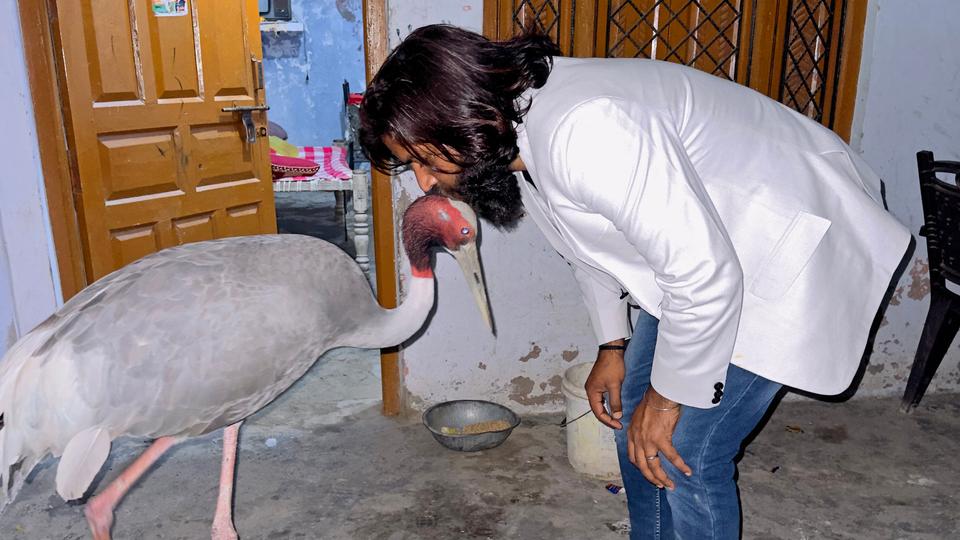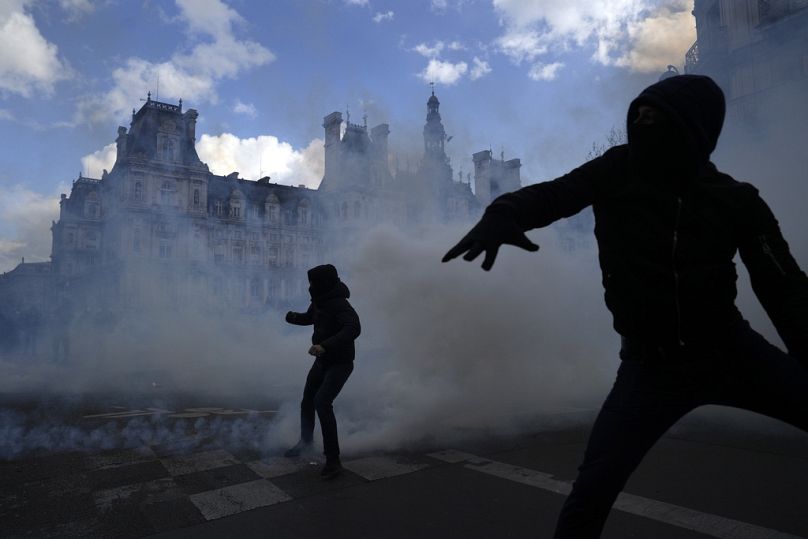Lula attends inauguration ceremony for Dilma Rousseff as NDB president
13-Apr-2023
CGTN
An inauguration ceremony was held for Dilma Rousseff, an economist and former Brazilian president, as New Development Bank (NDB) president in Shanghai on Thursday.
Brazilian President Luiz Inacio Lula da Silva, who arrived in Shanghai on Wednesday night to kick off his state visit to China, attended the ceremony.
This is the first time that a head of state visited the NDB bank's headquarters in Shanghai and addressed the NDB staff in person.
"The New Development Bank is the product of a partnership among BRICS countries with a view to creating a world with less poverty, less inequality and more sustainability. In taking office as bank president, Ms. Dilma Rousseff brings her extensive background and knowledge on public policies and the international scene, thus strengthening NDB's leading role in achieving a better world, without poverty or hunger," said Lula in a speech.
Rousseff emphasized the bank's commitment to supporting Brazil's sustainable development goals and highlighted the importance of the presidential visit for strengthening the cooperation between the NDB and Brazil.
"As a former president of Brazil, I know the importance of the work of multilateral banks to support developing countries, particularly NDB, in addressing their economic, social and environmental needs. Becoming the president of the NDB is undoubtedly a great opportunity to do more for the BRICS, the emerging markets and developing countries, and my own country – Brazil," said Rousseff.
The Board of Governors of the NDB unanimously elected Rousseff as the president of the bank on March 24, 2023.
The NDB is a multilateral development bank established by Brazil, Russia, India, China and South Africa (BRICS) with the purpose of mobilizing resources for infrastructure and sustainable development projects in emerging markets and developing countries.
CGTN
An inauguration ceremony was held for Dilma Rousseff, an economist and former Brazilian president, as New Development Bank (NDB) president in Shanghai on Thursday.
Brazilian President Luiz Inacio Lula da Silva, who arrived in Shanghai on Wednesday night to kick off his state visit to China, attended the ceremony.
This is the first time that a head of state visited the NDB bank's headquarters in Shanghai and addressed the NDB staff in person.
"The New Development Bank is the product of a partnership among BRICS countries with a view to creating a world with less poverty, less inequality and more sustainability. In taking office as bank president, Ms. Dilma Rousseff brings her extensive background and knowledge on public policies and the international scene, thus strengthening NDB's leading role in achieving a better world, without poverty or hunger," said Lula in a speech.
Rousseff emphasized the bank's commitment to supporting Brazil's sustainable development goals and highlighted the importance of the presidential visit for strengthening the cooperation between the NDB and Brazil.
"As a former president of Brazil, I know the importance of the work of multilateral banks to support developing countries, particularly NDB, in addressing their economic, social and environmental needs. Becoming the president of the NDB is undoubtedly a great opportunity to do more for the BRICS, the emerging markets and developing countries, and my own country – Brazil," said Rousseff.
The Board of Governors of the NDB unanimously elected Rousseff as the president of the bank on March 24, 2023.
The NDB is a multilateral development bank established by Brazil, Russia, India, China and South Africa (BRICS) with the purpose of mobilizing resources for infrastructure and sustainable development projects in emerging markets and developing countries.
"Why should every country have to be tied to the dollar for trade?" asks Brazil's President Lula during a ceremony in Shanghai while accusing IMF of "asphyxiating countries' economies."
"No leader can work with a knife to their throat because [their country] owes money," says Lula.
Brazilian President Luiz Inacio Lula da Silva has criticised the outsize role of the US dollar in the world economy and lashed out at the International Monetary Fund [IMF] during an official visit to China.
"Why should every country have to be tied to the dollar for trade?... Who decided the dollar would be the [world's] currency?" Lula said on Thursday in Shanghai at a ceremony to inaugurate his political ally Dilma Rousseff as president of the development bank set up by the BRICS nations [Brazil, Russia, India, China and South Africa].
"Why can't a bank like the BRICS bank have a currency to finance trade between Brazil and China, between Brazil and other BRICS countries?... Today, countries have to chase after dollars to export, when they could be exporting in their own currencies."
Lula also had strong words for the IMF, alluding to accusations the IMF forces overly harsh spending cuts on cash-strapped countries like Brazil's neighbour Argentina in exchange for bailout loans.
"No bank should be asphyxiating countries' economies the way the IMF is doing now with Argentina, or the way they did with Brazil for a long time and every third-world country," he said.
"No leader can work with a knife to their throat because [their country] owes money."
'Brazil is back!'
Lula, who took office in January, is looking to reposition Brazil as a global go-between and deal broker, seeking friendly ties across the board after four years of relative isolation under his far-right predecessor, Jair Bolsonaro.
He is due to meet with Chinese counterpart Xi Jinping in Beijing on Friday, and also visited US President Joe Biden in February.
"Brazil is back!" Lula promised in Shanghai, where he arrived on Wednesday night.
"The time when Brazil was absent from major world decisions is in the past. We are back on the international stage, after an inexplicable absence."
One of the main topics on the agenda when Lula and Xi meet on Friday is expected to be the Ukraine war.
Both China and Brazil have positioned themselves as mediators in the conflict, despite Western alleagtions that they are overly cosy with Russian President Vladimir Putin.
Both countries have refused to join Western nations in imposing sanctions on Russia for its invasion.
Trade ties
The Shanghai leg of Lula's trip highlighted another key goal of the visit — deepening trade ties between the Asian giant and Latin America's biggest economy.
China is Brazil's biggest export market, buying tens of billions of dollars' worth of soybeans, beef and iron ore.
Under the currency deal announced in March, Brazil and China have named two banks — one in each country — to conduct their massive trade and financial transactions by directly exchanging yuan for reais and vice versa, instead of going through the dollar.
After Rousseff's inauguration, Lula visited a research centre run by Chinese telecom giant Huawei.
Huawei's chair walked him through an exhibition showcasing the company's extensive presence in Brazil — a contrast with the United States, where companies are effectively barred from doing business with the firm.
Lula also met the head of China's biggest electric carmaker, BYD, which said in October that it planned to set up a vehicle manufacturing plant in northern Brazil's Bahia after Ford Motors closed its factory there.
The company is already making electric buses and cars in Brazil for the Latin American market.
The 77-year-old president was initially scheduled to make the trip in late March, but had to postpone it after coming down with pneumonia.
He is travelling with a large delegation of about 40 high-level officials, including cabinet ministers, governors and members of Congress.
He will wrap up his trip with a one-day official visit to the United Arab Emirates on Saturday.
Brazilian President Luiz Inacio Lula da Silva has criticised the outsize role of the US dollar in the world economy and lashed out at the International Monetary Fund [IMF] during an official visit to China.
"Why should every country have to be tied to the dollar for trade?... Who decided the dollar would be the [world's] currency?" Lula said on Thursday in Shanghai at a ceremony to inaugurate his political ally Dilma Rousseff as president of the development bank set up by the BRICS nations [Brazil, Russia, India, China and South Africa].
"Why can't a bank like the BRICS bank have a currency to finance trade between Brazil and China, between Brazil and other BRICS countries?... Today, countries have to chase after dollars to export, when they could be exporting in their own currencies."
Lula also had strong words for the IMF, alluding to accusations the IMF forces overly harsh spending cuts on cash-strapped countries like Brazil's neighbour Argentina in exchange for bailout loans.
"No bank should be asphyxiating countries' economies the way the IMF is doing now with Argentina, or the way they did with Brazil for a long time and every third-world country," he said.
"No leader can work with a knife to their throat because [their country] owes money."
'Brazil is back!'
Lula, who took office in January, is looking to reposition Brazil as a global go-between and deal broker, seeking friendly ties across the board after four years of relative isolation under his far-right predecessor, Jair Bolsonaro.
He is due to meet with Chinese counterpart Xi Jinping in Beijing on Friday, and also visited US President Joe Biden in February.
"Brazil is back!" Lula promised in Shanghai, where he arrived on Wednesday night.
"The time when Brazil was absent from major world decisions is in the past. We are back on the international stage, after an inexplicable absence."
One of the main topics on the agenda when Lula and Xi meet on Friday is expected to be the Ukraine war.
Both China and Brazil have positioned themselves as mediators in the conflict, despite Western alleagtions that they are overly cosy with Russian President Vladimir Putin.
Both countries have refused to join Western nations in imposing sanctions on Russia for its invasion.
Trade ties
The Shanghai leg of Lula's trip highlighted another key goal of the visit — deepening trade ties between the Asian giant and Latin America's biggest economy.
China is Brazil's biggest export market, buying tens of billions of dollars' worth of soybeans, beef and iron ore.
Under the currency deal announced in March, Brazil and China have named two banks — one in each country — to conduct their massive trade and financial transactions by directly exchanging yuan for reais and vice versa, instead of going through the dollar.
After Rousseff's inauguration, Lula visited a research centre run by Chinese telecom giant Huawei.
Huawei's chair walked him through an exhibition showcasing the company's extensive presence in Brazil — a contrast with the United States, where companies are effectively barred from doing business with the firm.
Lula also met the head of China's biggest electric carmaker, BYD, which said in October that it planned to set up a vehicle manufacturing plant in northern Brazil's Bahia after Ford Motors closed its factory there.
The company is already making electric buses and cars in Brazil for the Latin American market.
The 77-year-old president was initially scheduled to make the trip in late March, but had to postpone it after coming down with pneumonia.
He is travelling with a large delegation of about 40 high-level officials, including cabinet ministers, governors and members of Congress.
He will wrap up his trip with a one-day official visit to the United Arab Emirates on Saturday.
:quality(70)/cloudfront-eu-central-1.images.arcpublishing.com/thenational/2LQSEAM6X2F6REQEQUPBYWFA64.jpg)
:quality(70)/cloudfront-eu-central-1.images.arcpublishing.com/thenational/64VG4RKNZZFMZLWTKDSM6LDWRA.jpg)











